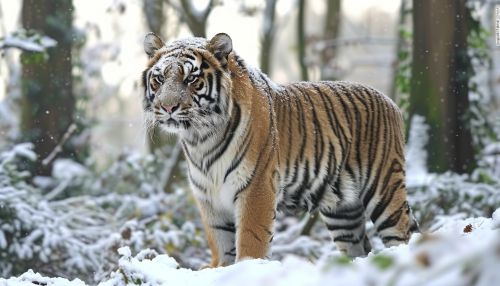Siberian tiger
Introduction
The Siberian tiger (Panthera tigris altaica), also known as the Amur tiger, is a tiger subspecies native to the Russian Far East, Northeast China, and possibly North Korea. It is the largest extant cat species and a member of the genus Panthera. The Siberian tiger is distinguished by its pale coat, which is thicker than that of other tiger subspecies, and its large size, with males weighing up to 320 kg (710 lb) and measuring up to 3.3 m (10.8 ft) in total length.


Taxonomy and Evolution
The Siberian tiger belongs to the family Felidae and the genus Panthera. The subspecies was first described by the German zoologist Coenraad Jacob Temminck in 1844. Genetic studies have shown that the Siberian tiger is closely related to the Caspian tiger (Panthera tigris virgata), which is now extinct. Both subspecies are believed to have diverged from a common ancestor approximately 10,000 years ago.
The evolutionary history of the Siberian tiger is complex, involving multiple migrations and genetic bottlenecks. Fossil evidence suggests that tigers once ranged widely across Asia, from the Caucasus to the islands of Sumatra and Java. The Siberian tiger's ancestors adapted to the cold climates of the Russian Far East, developing thicker fur and larger body sizes to conserve heat.
Physical Characteristics
Siberian tigers are the largest of all tiger subspecies. Males typically weigh between 180 and 320 kg (397 and 705 lb), while females weigh between 100 and 167 kg (220 and 368 lb). The body length of males ranges from 190 to 230 cm (75 to 91 in), with a tail length of 80 to 110 cm (31 to 43 in). Females are generally smaller, with body lengths of 160 to 180 cm (63 to 71 in) and tail lengths of 70 to 95 cm (28 to 37 in).
The coat of the Siberian tiger is pale orange with narrow black stripes. The fur is thick and dense, especially during the winter months, providing insulation against the harsh cold. The underparts, including the chest, belly, and inner sides of the limbs, are white. The face is characterized by prominent white whiskers and a white area around the eyes, which helps to reduce glare from the snow.
Habitat and Distribution
The primary habitat of the Siberian tiger is the taiga and boreal forests of the Russian Far East, particularly in the Sikhote-Alin mountain range. These forests are characterized by a mix of coniferous and deciduous trees, with dense undergrowth and a thick layer of snow in winter. The region's harsh climate and rugged terrain provide a challenging environment for the tigers, but also offer ample cover and prey.
Historically, the range of the Siberian tiger extended into Northeast China and the Korean Peninsula. However, habitat loss and hunting have significantly reduced their distribution. Today, the majority of the population is confined to the Russian Far East, with small, fragmented populations in China and possibly North Korea.
Behavior and Ecology
Siberian tigers are solitary and territorial animals. Males establish large territories that overlap with those of several females, while females maintain smaller territories that they defend against other females. The size of a territory depends on the availability of prey and the density of the tiger population. In the Russian Far East, male territories can cover up to 1,000 square kilometers (390 square miles), while female territories are typically around 400 square kilometers (150 square miles).
The diet of the Siberian tiger consists primarily of large ungulates, such as red deer (Cervus elaphus), wild boar (Sus scrofa), and sika deer (Cervus nippon). They are also known to prey on smaller animals, including hares, raccoon dogs, and Asian black bears. Tigers are ambush predators, relying on stealth and strength to capture their prey. They can consume up to 40 kg (88 lb) of meat in a single meal and may go several days without eating after a large kill.
Reproduction and Lifespan
Siberian tigers reach sexual maturity at around three to four years of age. Mating can occur at any time of the year, but most births take place in the spring or summer. After a gestation period of approximately 105 days, the female gives birth to a litter of one to four cubs. The cubs are born blind and helpless, weighing about 1 kg (2.2 lb) each. They rely on their mother for nourishment and protection during the first few months of life.
The mother raises the cubs alone, teaching them to hunt and survive in the wild. The cubs begin to accompany their mother on hunts at around six months of age and are fully weaned by the time they are one year old. They remain with their mother until they are about two to three years old, at which point they disperse to establish their own territories.
In the wild, Siberian tigers have a lifespan of 10 to 15 years, although some individuals have been known to live up to 20 years. In captivity, they can live even longer, with some tigers reaching over 25 years of age.
Conservation Status
The Siberian tiger is classified as Endangered on the IUCN Red List of Threatened Species. The primary threats to their survival are habitat loss, poaching, and depletion of prey populations. Deforestation and human encroachment have fragmented their habitat, making it difficult for tigers to find sufficient food and mates. Poaching for their fur, bones, and other body parts remains a significant problem, driven by demand in traditional medicine and the illegal wildlife trade.
Conservation efforts have been underway for several decades to protect the Siberian tiger and its habitat. In Russia, the establishment of protected areas, such as the Sikhote-Alin Biosphere Reserve, has helped to safeguard critical tiger habitats. Anti-poaching measures, including increased patrolling and stricter enforcement of wildlife protection laws, have also contributed to the stabilization of the tiger population.
International cooperation is essential for the conservation of the Siberian tiger, as their range extends across national borders. Organizations such as the World Wildlife Fund (WWF) and the Wildlife Conservation Society (WCS) work with local governments and communities to implement conservation strategies and raise awareness about the importance of protecting these majestic animals.
Genetic Diversity and Health
Maintaining genetic diversity is crucial for the long-term survival of the Siberian tiger population. Inbreeding can lead to a decrease in genetic variability, making the population more susceptible to diseases and reducing their ability to adapt to environmental changes. Genetic studies have shown that the Siberian tiger population has relatively low genetic diversity compared to other tiger subspecies, likely due to historical population bottlenecks.
Conservation programs often include measures to enhance genetic diversity, such as translocating individuals between isolated populations and establishing breeding programs in captivity. The Amur Tiger Reintroduction Project is one such initiative that aims to reintroduce captive-bred tigers into the wild to bolster the genetic pool and increase the overall population size.
Human-Tiger Conflict
Human-tiger conflict is a significant challenge in the conservation of the Siberian tiger. As human populations expand and encroach on tiger habitats, encounters between tigers and people become more frequent. Tigers may prey on livestock, leading to economic losses for local communities and retaliatory killings of tigers. Additionally, tigers that become habituated to human presence may pose a direct threat to human safety.
Mitigating human-tiger conflict involves a combination of strategies, including the use of predator-proof livestock enclosures, compensation schemes for livestock losses, and community-based conservation programs. Educating local communities about the ecological importance of tigers and involving them in conservation efforts can also help to reduce conflict and promote coexistence.
Cultural Significance
The Siberian tiger holds significant cultural and symbolic value in the regions where it is found. In Russian folklore, the tiger is often depicted as a powerful and revered animal, embodying strength and courage. The indigenous Udege and Nanai peoples of the Russian Far East regard the tiger as a sacred creature and a guardian of the forest. Traditional beliefs and practices emphasize the need to respect and protect the tiger, reflecting a deep connection between the people and their natural environment.
In modern times, the Siberian tiger has become a symbol of wildlife conservation and environmental protection. Efforts to save the tiger are often highlighted in media campaigns and public awareness initiatives, drawing attention to broader issues of biodiversity loss and habitat destruction.
Research and Monitoring
Ongoing research and monitoring are essential for understanding the ecology and behavior of the Siberian tiger and for informing conservation strategies. Scientists use a variety of methods to study tigers in the wild, including camera traps, radio telemetry, and genetic analysis. These techniques provide valuable data on tiger population size, distribution, movement patterns, and genetic health.
Camera traps are widely used to capture images of tigers and other wildlife, allowing researchers to identify individual tigers based on their unique stripe patterns. Radio telemetry involves fitting tigers with GPS collars to track their movements and study their habitat use and territorial behavior. Genetic analysis of scat samples and other biological materials helps to assess genetic diversity and identify relatedness among individuals.
Collaboration between researchers, conservation organizations, and government agencies is crucial for the success of these monitoring efforts. Data collected from field studies can be used to develop and implement effective conservation policies and management plans.
Future Prospects
The future of the Siberian tiger depends on continued conservation efforts and the commitment of the international community to protect this iconic species. While significant progress has been made in stabilizing the tiger population in recent years, challenges remain. Habitat loss, poaching, and human-tiger conflict continue to threaten the survival of the Siberian tiger.
Innovative conservation approaches, such as the use of conservation drones for anti-poaching patrols and the development of wildlife corridors to connect fragmented habitats, offer promising solutions. Engaging local communities in conservation initiatives and promoting sustainable land-use practices can also help to create a more harmonious coexistence between humans and tigers.
Ultimately, the preservation of the Siberian tiger is not only about saving a single species but also about protecting the rich biodiversity and ecological integrity of the forests they inhabit. By safeguarding the tiger, we also protect countless other species and the ecosystems that support them.
